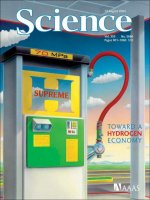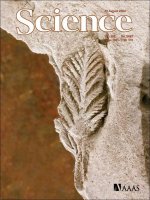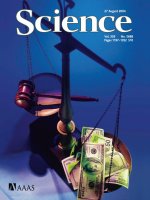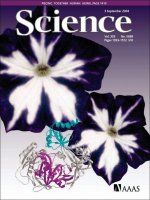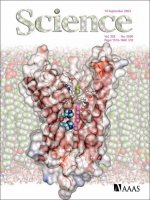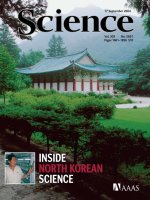- Trang chủ >>
- Khoa Học Tự Nhiên >>
- Vật lý
Tạp chí khoa học số 2005-04-01
Bạn đang xem bản rút gọn của tài liệu. Xem và tải ngay bản đầy đủ của tài liệu tại đây (15.72 MB, 152 trang )
1 April 2005
Vol. 308 No. 5718
Pages 1 –148 $10
1 April 2005
Vol. 308 No. 5718
Pages 1 –148 $10
TLFeBOOK
TLFeBOOK
Need More Information? Give Us A Call:
#/2.+(+%#6+10 %' $+1.1); %.10+0) /+%41#44#;5
07%.'+%#%+&
#0#.;5+5
2416'+0(70%6+10
#0#.;5+5
37#06+6#6+8'
2%4
51(69#4'
51.76+105
YYYUVTCVCIGPGEQO
Stratagene Europe
Order: 00800-7000-7000
Technical Services: 00800-7400-7400
GeneMorph
®
random mutagenesis kits
*
feature our patented Mutazyme
®
II
DNA polymerase, which delivers a balanced mutational spectrum with more
robust yields than
Taq
polymerase under error-prone PCR conditions. This
allows you to discover more key residues responsible for protein function
easier and faster than before, thus enhancing the evolution of your protein.
• Simple protocol to control mutation frequency
• Efficient mutagenesis rates of 1 to 16 bases per kb
• Overcome poor PCR yield and mutational bias of
Taq
polymerase
The perfect assortment.
With GeneMorph
®
mutagenesis kits, a balanced
spectrum of mutations is right at your fingertips.
10%Value 20% 30% 40% 50% 60% 70% 80%
Mutazyme
®
II
DNA Polymerase
Mutazyme
®
I
DNA Polymerase
Taq
DNA Polymerase
AT to N GC to N
Our GeneMorph
®
II Kits include Mutazyme
®
II Polymerase,
which delivers a balanced mutational spectrum.
Ask us about these great products:
GeneMorph
®
II Random Mutagenesis kit 30 rxns 200550
GeneMorph
®
II EZClone Domain Mutagenesis kit 10 rxns 200552
Purchase of these products is accompanied by a license to use them in the Polymerase Chain Reaction
(PCR) process in conjunction with a thermal cycler whose use in the automated
performance of the PCR process is covered by the up-front license fee, either by payment
to Applied Biosystems or as purchased, i.e., an authorized thermal cycler.
Stratagene USA and Canada
Order: (800) 424-5444 x3
Technical Services: (800) 894-1304
Stratagene Japan K.K.
Order: 03-5159-2060
Technical Services: 03-5159-2070
* U.S. Patent No. 6,803,216 and patent pending
TLFeBOOK
Ni Sepharose
™
products from GE Healthcare give you the highest binding
capacity available for histidine-tagged protein purification. With up to four times
the binding capacity, it’s no longer pure imagination to dramatically increase your
yield, while saving time and costs. Maximum target protein activity is assured,
thanks to tolerance of a wide range of additives and negligible nickel ion leakage.
The flexibility to use a variety of protocols ensures the highest possible purity.
Ni Sepharose 6 FF is excellent for manual procedures such as gravity/batch and
easy scale-up, while the HP version is designed for high-performance in automated
purification systems – both are available in different formats, including prepacked
columns. Outstanding performance has never been easier to achieve.
www.amershambiosciences.com/his
4x greater binding capacity
in histidine-tagged
protein purification
GE Healthcare
© 2005 General Electric Company - All rights reserved.
Amersham Biosciences AB, a General Electric company
going to market as GE Healthcare.
GE10-05
TLFeBOOK
www.sciencemag.org SCIENCE VOL 308 1 APRIL 2005
5
DEPARTMENTS
11 SCIENCE ONLINE
13 THIS WEEK IN SCIENCE
17 EDITORIAL by Donald Kennedy
All Fools’ Day
19 E
DITORS’CHOICE
24 CONTACT SCIENCE
29 NETWATCH
124 NEW PRODUCTS
125 SCIENCE CAREERS
NEWS OF THE WEEK
30
U.K. BIOETHICS
Divided Committee Urges Less
Restriction on Embryo Research
31
S
ELECT AGENTS
Researchers Relieved by Final Biosecurity Rules
31
I
NFECTIOUS DISEASES
A Puzzling Outbreak of Marburg Disease
33
S
PACE EXPLORATION
Japan Weighs Moon and Beyond
33 S
CIENCESCOPE
34
FRENCH SCIENCE
Politician Sails Into a Storm at Oceans Agency
35
I
TALIAN RESEARCH
Universities and Institutes Face Industrial
Revolution
36
N
EUROSCIENCE
Economic Game Shows How the Brain
Builds Trust
related Research Article page 78
36 MATHEMATICS
‘Cranky’ Proof Reveals Hidden Regularities
37
A
CADEMIC JOBS
Tenured UCLA Professor Under Fire
NEWS FOCUS
38 PHYSICS
High-Energy Physics: Exit America?
41
E
COLOGY
Taking the Pulse of Earth’s
Life-Support Systems
Choose Your Own World
44
MEETING
American Chemical Society
Unnatural Amino Acid Could Prove Boon
for Protein Therapeutics
Nanofibers Seed Blood Vessels
Fast, Sensitive Scan Targets Anthrax
46 RANDOM SAMPLES
LETTERS
49 NIH Response to Open Letter A. S. Fauci and
E. A. Zerhouni. The Past and Future of Extant
Amphibians M. Delfino. Response S. N. Stuart et al.
Don’t Call Them Co-eds! D. M. Riley. The Source of
the Lisbon Earthquake J. F. B. D. Fonseca. Response
M A. Gutscher
BOOKS ET AL.
53 FOOD
Uncorked: The Science of Champagne G. Liger-Belair;
Great Wine Terroirs J. Fanet, translated by F. Brutton,
reviewed by S.West
54 BIOMEDICINE
Cells,Aging, and Human Disease
M. B. Fossel, reviewed by S. N.Austad
ESSAY
55 GLOBAL VOICES OF SCIENCE
When Science Is Not Enough:
Fighting Genetic Disease in Brazil
M. Zatz
PERSPECTIVES
58 PHYSIOLOGY
Walking Made Simple
R. M. Alexander
59 GEOLOGY
The Calibration of Ediacaran Time
A. J. Kaufman
related Report page 95
60 EVOLUTION
Where We’re Hot, They’re Not
L. B. Jorde
related Report page 107
62 PSYCHOLOGY
Beyond a Joke: From Animal Laughter to
Human Joy?
J. Panksepp
63 MATERIALS SCIENCE
Playing Nature’s Game with Artificial Muscles
R. H. Baughman
65 CELL BIOLOGY
Kinasing and Clipping Down the NF-κB Trail
N. S. C. van Oers and Z. J. Chen
related Report page 114
REVIEW
67
ATMOSPHERIC SCIENCE
Global Iron Connections Between Desert Dust,
Ocean Biogeochemistry, and Climate
T. D. Jickells et al.
Contents continued
COVER The ability to trust another human is a crucial component of normal social
interaction. Hyperscanning, a brain imaging approach for multibrain recording, reveals
the related activity in two brains as trust is built during a monetary exchange game.
See page 78. [Image: Min Kim/Human Neuroimaging Laboratory/BCM]
53
55
Volume 308
1 April 2005
Number 5718
38
TLFeBOOK
Integrated Solutions — Automated Sample Preparation
Free up your time — leave your sample
preparation to the affordable BioSprint 15!
Efficient amplification of the single-
copy gene MECL-1 from a range of
cultured-cell samples
New
M BJAB HeLa S3 HL-60 –+
WWW.QIAGEN.COM
Save time and effort by automating your sample preparation!
The new BioSprint 15 workstation and kits provide rapid and cost-efficient sample preparation
for a wide range of applications. Kits enabling purification of high-quality genomic DNA from
cells, tissue, and blood are available now, with more applications to follow. Look for the new
protein purification kits, available in early 2005!
The BioSprint 15 workstation and expanding range of kits give you:
■ A convenient automated procedure — saving you time and effort
■ A cost-effective solution — economically priced automation for 1–15 samples per run
■ Fast startup and immediate results — with easy-to-use, preinstalled BioSprint protocols
■ Flexibility and versatility — use the protocols supplied or easily design your own
BioSprint workstations and kits are intended as general-purpose devices that may be used in clinical diagnostic laboratory systems after the laboratory has validated
their complete system as required by CLIA '88 regulations in the U.S. or equivalents in other countries. QIAGEN robotic systems are not available in all countries;
please inquire. The PCR process is covered by U.S. Patents 4,683,195 and 4,683,202 and foreign equivalents owned by Hoffmann-La Roche AG.
IASBSp150904S1WW © 2004 QIAGEN, all rights reserved.
Visit www
.qiagen.com/goto/BioSprint15 to see how the BioSprint 15 can
free up your time!
TLFeBOOK
www.sciencedigital.org/subscribe
For just US$130, you can join AAAS TODAY and
start receiving Science Digital Edition immediately!
TLFeBOOK
www.sciencedigital.org/subscribe
For just US$130, you can join AAAS TODAY and
start receiving Science Digital Edition immediately!
TLFeBOOK
www.sciencemag.org SCIENCE VOL 308 1 APRIL 2005
7
S
CIENCE
EXPRESS www.sciencexpress.org
CHEMISTRY: An Octane-Fueled Solid Oxide Fuel Cell
Z. Zhan and S. A. Barnett
Adding a cerium and ruthenium oxide layer over the nickel anode of a high-temperature fuel cell that consumes
hydrocarbons prevents deposition of potentially deactivating carbon layers.
CELL BIOLOGY: The Kinase Domain of Titin Controls Muscle Gene Expression and Protein
Turnover
S. Lange, F. Xiang, A. Yakovenko,A.Vihola, P. Hackman, E. Rostkova, J. Kristensen,
B. Brandmeier, G. Franzen, B. Hedberg, L. G. Gunnarsson, S. M. Hughes, S. Marchand,
T. Sejersen, I. Richard, L. Edström, E. Ehler, B. Udd, M. Gautel
The giant muscle protein titan communicates mechanical changes in muscle cells to the nucleus in
order to remodel muscle characteristics in response to use.
BIOCHEMISTRY: Structure of the Rotor of the V-type Na
+
-ATPase from Enterococcus hirae
T. Murata, I.Yamato, Y. Kakinuma,A. G. W. Leslie, J. E. Walker
To operate, the outside half-channel of the sodium pump rotates into place, releasing a sodium ion from
the internal binding site, and then the site is refilled through an internal half-channel.
BIOCHEMISTRY: Human Mpp11 J Protein: Ribosome-Tethered Molecular Chaperones Are
Ubiquitous
H. A. Hundley, W.Walter, S. Bairstow, E. A. Craig
Molecular chaperones that help fold proteins as they emerge from the ribosome are similar in yeast and human
cells but distinct from those found in bacteria.
TECHNICAL COMMENT ABSTRACTS
52
CELL SIGNALING
Comment on “Oscillations in NF-κB Signaling Control the Dynamics of Gene Expression”
D. Barken, C. J. Wang, J. Kearns, R. Cheong, A. Hoffmann, A. Levchenko
full text at www.sciencemag.org/cgi/content/full/308/5718/52a
Response to Comment on “Oscillations in NF-κB Signaling Control the Dynamics of Gene
Expression”
D. E. Nelson, C. A. Horton, V. See, J. R. Johnson, G. Nelson, D. G. Spiller, D. B. Kell,
M. R. H.White
full text at www.sciencemag.org/cgi/content/full/308/5718/52b
BREVIA
73 ATMOSPHERIC SCIENCE: Abundance of Cellular Material and Proteins in the Atmosphere
R. Jaenicke
Particles made from cell fragments and proteins form a surprisingly large fraction of atmospheric aerosols.
RESEARCH ARTICLES
74 OCEAN SCIENCE: Role of Marine Biology in Glacial-Interglacial CO
2
Cycles
K. E. Kohfeld, C. Le Quéré, S. P. Harrison, R. F. Anderson
Sediment records of biological activity show that high productivity and burial of organic carbon was insufficient
to account for low atmospheric CO
2
levels during glaciation, as had been thought.
78 NEUROSCIENCE: Getting to Know You: Reputation and Trust in a Two-Person Economic
Exchange
B. King-Casas, D.Tomlin, C. Anen, C. F. Camerer, S. R. Quartz, P. R. Montague
During a game in which players learn whether their partner is selfish or generous, neurons in the middle of
the brain show activity that reflects the level of trust being built.
related News story page 36
83 NEUROSCIENCE: Postsynaptic Receptor Trafficking Underlying a Form of Associative Learning
S. Rumpel, J. LeDoux, A. Zador, R. Malinow
In order for rats to learn to associate a tone with a shock, at least 35% of the neurons in their amygdala must
form stronger synapses; fewer enhanced synapses cannot support learning.
REPORTS
88 PHYSICS: Spin-Charge Separation and Localization in One Dimension
O. M. Auslaender, H. Steinberg, A. Yacoby,Y.Tserkovnyak, B. I. Halperin, K.W. Baldwin,
L. N. Pfeiffer, K.W.West
A coupled pair of wires provides a one-dimensional system for demonstrating the quantum separation of
electron spin and charge, as predicted by theory.
Contents continued
98
TLFeBOOK
NeutrAvidin
™
Protein offers the highest possible specificity
for biotin, yielding the lowest nonspecific binding.
NeutrAvidin
™
Protein provides exceptional performance
for both purification and detection of biotin-labeled
proteins. If you’re still using Streptavidin, it’s time to
discover the advantages of NeutrAvidin
™
Tools.
Advantages over streptavidin:
• Highest specificity for biotin binding
• No nonspecific binding to cell-surface proteins
• High signal-to-noise ratio in detection systems
• Saves money without sacrificing quality
Still using Streptavidin?
NeutrAvidin
™
Protein offers ultra-low nonspecific
binding at an unbelievably low price
Protein Purification/Detection
Properties of biotin-binding proteins
www.piercenet.com/neu22d
Grasp the Proteome
™
FREE Avidin-Biotin Handbook from
Pierce, the leader in avidin-biotin
products! Visit the Pierce web site at
www.piercenet.com/ab95d or call
800-874-3723 to request your copy today.
Tel: 815-968-0747 or 800-874-3723 • Fax: 815-968-7316
Technical Assistance E-mail: • Customer Assistance E-mail:
Outside the United States, visit our web site or call 815-968-0747 to locate your local Perbio Science branch office (below) or distributor
© Pierce Biotechnology, Inc., 2005. Pierce products are supplied for laboratory or manufacturing applications only.
NeutrAvidin
™
and UltraLink
®
are trademarks of Pierce Biotechnology, Inc.
Belgium & Dist.:
Tel +32 53 85 71 84
China:
Tel +86 10 8049 9033
France:
Tel 0800 50 82 15
Germany:
Tel 0228 9125650
Hong Kong:
Tel 852 2753 0686
The Netherlands:
Tel 076 50 31 880
United Kingdom:
Tel 0800 252185
Switzerland:
Tel 0800 56 31 40
Available in bulk quantities and in the following
convenient formats:
• Immobilized NeutrAvidin
™
Protein on Agarose
• UltraLink
®
Immobilized NeutrAvidin
™
Protein
• Soluble NeutrAvidin
™
Protein
• HRP- and Alkaline Phosphatase-labeled
NeutrAvidin
™
Protein
• Fluorescein-labeled NeutrAvidin
™
Protein
• Maleimide-activated NeutrAvidin
™
Protein
• 96- and 384-well NeutrAvidin
™
Plates
NeutrAvidin
™
Avidin Streptavidin Protein
Molecular Weight 67K 53K 60K
Biotin-binding 444
Sites
Isoelectric 10 6.8-7.5 6.3
Point (pI)
Specificity Low High Highest
Affinity for 10
-15
M10
-15
M10
-15
M
Biotin (K
d
)
Nonspecific High Low Lowest
Binding
TLFeBOOK
www.sciencemag.org SCIENCE VOL 308 1 APRIL 2005
9
92 MATERIALS SCIENCE: Simultaneous Tomography and Diffraction Analysis of Creep Damage
A. Pyzalla, B. Camin, T. Buslaps, M. Di Michiel, H. Kaminski, A. Kottar, A. Pernack, W. Reimers
Imaging with high-energy synchrotron radiation shows that pores in a brass alloy grow exponentially as it
slowly deforms.
95 GEOLOGY: U-Pb Ages from the Neoproterozoic Doushantuo Formation, China
D. Condon, M. Zhu, S. Bowring, W.Wang, A. Yang,Y. Jin
The Doushantuo Formation in China, containing a record of Earth’s earliest animals, was deposited over a
long interval, between 635 and 550 million years ago, after a global glaciation. related Perspective page 59
98 POLICY: Mortality and Greenhouse Gas Impacts of Biomass and Petroleum Energy Futures
in Africa
R. Bailis, M. Ezzati, D. M. Kammen
A switch from indoor burning of wood and dung to charcoal would produce substantial health benefits in
sub-Saharan Africa; switching to fossil fuels would help even more.
103
PALEONTOLOGY: A Late Jurassic Digging Mammal and Early Mammalian Diversification
Z X. Luo and J. R.Wible
A previously unknown lineage of extinct mammals originating about 150 million years ago evolved
aardvark-like specialized limbs for digging and teeth for eating termites.
107 GENETICS: Comparison of Fine-Scale Recombination Rates in Humans and Chimpanzees
W.Winckler, S. R. Myers, D. J. Richter, R. C. Onofrio, G. J. McDonald, R. E. Bontrop, G.A.T. McVean,
S. B. Gabriel, D. Reich, P. Donnelly, D. Altshuler
Hotspots of recombination occur at completely different points in human and chimpanzee genomes,
indicating unexpected complexity in the evolution of recombination rate.
related Perspective page 60
111 NEUROSCIENCE: Neuronal Coherence as a Mechanism of Effective Corticospinal Interaction
J M. Schoffelen, R. Oostenveld, P. Fries
In preparation for voluntary movement, activity in the motor cortex synchronizes with that in the spinal
cord, facilitating rapid transfer of neural signals.
114 CELL SIGNALING: PDK1 Nucleates T Cell Receptor–Induced Signaling Complex for NF-κB
Activation
K Y. Lee, F. D’Acquisto, M. S. Hayden, J H. Shim, S. Ghosh
Antigens initiate immune responses through a lipid-dependent kinase that recruits other related enzymes
to form membrane signaling rafts.
related Perspective page 65
118 MOLECULAR BIOLOGY: RNA Polymerase IV Directs Silencing of Endogenous DNA
A. J. Herr, M. B. Jensen, T. Dalmay, D. C. Baulcombe
A newly described polymerase found only in plants is required for small RNAs to silence transgenes and a
retroelement in Arabidopsis.
120 STRUCTURAL BIOLOGY: Translational Operator of mRNA on the Ribosome: How Repressor
Proteins Exclude Ribosome Binding
L. Jenner, P. Romby, B. Rees, C. Schulze-Briese, M. Springer, C. Ehresmann, B. Ehresmann, D. Moras,
G. Yusupova, M. Yusupov
An enzyme blocks its own translation into protein by binding to a specific site on its mRNA and thus
hindering binding of the mRNA to the ribosome.
SCIENCE (ISSN 0036-8075) is published weekly on Friday, except the last week in December, by the American Association for the Advancement of
Science, 1200 New York Avenue, NW,Washington, DC 20005. Periodicals Mail postage (publication No. 484460) paid at Washington, DC, and additional
mailing offices. Copyright © 2005 by the American Association for the Advancement of Science.The title SCIENCE is a registered trademark of the AAAS.
Domestic individual membership and subscription (51 issues): $135 ($74 allocated to subscription). Domestic institutional subscription (51 issues): $550;
Foreign postage extra: Mexico, Caribbean (surface mail) $55; other countries (air assist delivery) $85. First class, airmail, student, and emeritus rates on
request. Canadian rates with GST available upon request, GST #1254 88122. Publications Mail Agreement Number 1069624. Printed in the U.S.A.
Change of address: allow 4 weeks, giving old and new addresses and 8-digit account number. Postmaster: Send change of address to Science, P.O. Box 1811, Danbury, CT 06813–1811. Single copy sales: $10.00
per issue prepaid includes surface postage; bulk rates on request. Authorization to photocopy material for internal or personal use under circumstances not falling within the fair use provisions of the Copyright
Act is granted by AAAS to libraries and other users registered with the Copyright Clearance Center (CCC) Transactional Reporting Service, provided that $15.00 per article is paid directly to CCC, 222 Rosewood
Drive, Danvers, MA 01923. The identification code for Science is 0036-8075/83 $15.00. Science is indexed in the Reader’s Guide to Periodical Literature and in several specialized indexes.
Contents continued
REPORTS CONTINUED
60 & 107
103
TLFeBOOK
Practice of the patented polymerase chain reaction (PCR) process requires a license. The MJ Mini thermal cycler and the MiniOpticon
system include an Authorized Thermal Cycler, and may be used with PCR licenses available from Applied Biosystems. Their use with
Authorized Reagents also provides a limited PCR license in accordance with the label rights accompanying such reagents. Some
applications may also require licenses from other third parties.
Visit us on the Web at discover.bio-rad.com
Call toll free at 1-800-4BIORAD (1-800-424-6723);
outside the US, contact your local sales office.
The MJ Line of Amplification Products
A giant among its peers.
Introducing the MJ Mini
™
thermal cycler and MiniOpticon
™
real-time PCR system:
Small on size, big on performance.
The 48-well MJ Mini cycler delivers the high-performance features found
in higher-capacity instruments. When fitted with a two-color real-time
detector, it’s transformed into the MiniOpticon real-time system — one
of the smallest and most portable real-time PCR systems available.
■
A thermal gradient optimizes reactions for maximum efficiency
and accurate quantification
■
Fast achievement of thermal uniformity ensures reliable results
and shortened run times
■
The MiniOpticon system incorporates an array of 48 LEDs
for excitation and a pair of sensitive photodiodes for detection
in a robust design with no moving parts
■
Light weight and compact size allow these systems to fit just
about anywhere
For more information, visit us on the Web at www.bio-rad.com/ad/mini/
MJ Mini cycler — 18 x 32 x 20 cm; 4 kg
MiniOpticon system — 18 x 32 x 33 cm; 8 kg
TLFeBOOK
11
www.sciencemag.org SCIENCE VOL 308 1 APRIL 2005
sciencenow www.sciencenow.org DAILY NEWS COVERAGE
More Than One Way to Skin a Cat Allergy
Researchers tackle condition by creating a cat-human hybrid.
Save a Lizard, Save a Plant
New findings illustrate delicate interdependence between flora and fauna.
What Color Are Your 2’s?
Study provides new insights into why letters and numbers look different to synesthetes.
science’s next wave www.nextwave.org CAREER RESOURCES FOR YOUNG SCIENTISTS
US: Bridges to Nowhere? J.Austin
A new National Research Council report contains some intriguing proposals for postdocs.
CANADA: Visualizing Science at University of Toronto A. Fazekas
The Biomedical Communications program prepares students for careers in scientific visualization.
NETHERLANDS: Young Scientists Take to the Streets T.Vrijenhoek
Does taking time to communicate science to the public help or hinder a young scientist’s career?
MISCINET: A GEM of a Program C. Parks
The Graduate Degrees for Minorities for Engineering and Science Consortium provides funding and
support to underrepresented minority graduate students.
POSTDOC NETWORK: A Taxing Question on Postdoc Pay B. Benderly
New IRS regulation demands deductions from all postdocs.
GRANTSNET: April 2005 Funding News Next Wave Staff
Get the latest index of research funding opportunities, scholarships, fellowships, and internships.
science’s sage ke www.sageke.org SCIENCE OF AGING KNOWLEDGE ENVIRONMENT
NEWS FOCUS: Feeling Spunky with JNK R. J. Davenport
Protein funnels stress signals into insulin pathway and extends life.
NEWS FOCUS: Mopping Up Nuclear Waste M. Leslie
Molecule helps dispose of damaged proteins in the cell’s command center.
science’s stke www.stke.org SIGNAL TRANSDUCTION KNOWLEDGE ENVIRONMENT
PERSPECTIVE: Meeting Report—The Future and Limits of Systems Biology E. Werner
Who will prove more important as engineers and biologists tackle the new frontiers of systems biology?
EVENTS
Check out the updates to this list of meetings and conferences relevant to cell signaling.
Multicellular signaling
systems.
JNK nudges Foxo to center stage.
Success with GEM.
GrantsNet
www.grantsnet.org
R
ESEARCH FUNDING DATABASE
AIDScience
www.aidscience.com
HIV P
REVENTION & VACCINE RESEARCH
Functional Genomics
www.sciencegenomics.org
N
EWS,RESEARCH,RESOURCES
Members Only!
www.AAASMember.org
AAAS O
NLINE COMMUNITY
www.scienceonline.org
Separate individual or institutional subscriptions to these products may be required for full-text access.
TLFeBOOK
Our global network is your advantage –
Everywhere under the sun!
www.gbo.com/bioscience/distribution
Greiner Bio-One is a leading designer,
manufacturer, and supplier of leading
edge consumables to biotechnology,
diagnostic and pharmaceutical partners
worldwide.
Offering an unsurpassed scope of
products and services across a
variety of disciplines, we focus on the
evolving needs of our customers in the
development of innovative products, to
refine existing technologies, and redefine
the state of the art.
Our fast and flexible response for
customer specific programs, combined
with multiple strategic manufacturing
sites, ensures an uninterrupted supply
of critical components to meet your
product needs.
With worldwide locations and effective
global distribution, you will always be
within reach of the service, product and
support you need, everywhere under
the sun.
To find the Greiner Bio-One location
most convenient for you visit us at
www
.gbo.com/bioscience/distribution.
For further information please contact Greiner Bio-One: Germany (Main office): (+49) 7022 948-0 · info
@
de.gbo.com
Belgium: (+32) 2-4 6109 10 · info
@
be.gbo.com, France: (+33) 169-86 25 50 · infos
@
fr.gbo.com, Japan: (+81) 3-35 05-88 75 · info
@
jp.gbo.com
Netherlands: (+31) 172-42 09 00 · info
@
nl.gbo.com, UK: (+44) 14 53-82 52 55 · info
@
uk.gbo.com, USA: (+1) 800-8 84-47 03 · info
@
us.gbo.com
TLFeBOOK
Probing Luttinger Liquids
Strongly interacting electron systems in low dimensions provide a
theoretically tractable system for studying such complex electronic
interactions. However, experimental realization and probing of such
systems has lagged behind the theoretical efforts. Auslaender et al.
(p. 88) now play catch-up with their study of the fractionalization
of electrons in a well-controlled one-dimensional system. Using a
pair of coupled semiconducting wires with variable electron density,
they directly measured the
spin and charge excitations
of the system and followed
the dispersive behavior of
the electronic transport as a
function of the strength of
the Coulomb interaction.
They found clear evidence
for the theoretically pre-
dicted separation of the
spin and charge degrees
of freedom.
Sneaking a Peak at
Creep
Creep is the slow deforma-
tion of a material that oc-
curs when it is held under
constant load, such as the
gradual stretching of a pi-
ano or violin string. During
creep in a metal or metallic
alloy, voids form and grow
with time, in addition to
changes in the texture and
orientation of the crystal
grains. Pyzalla et al. (p. 92)
have developed a technique
to monitor all of these changes at once, and they use it to track
creep in a brass alloy. They confirm that the transition from homo-
geneous creep to localized deformation occurs late in the creep
process and suggest ways of how other simultaneous diffraction
and tomography measurements may be used to track crack growth
or load partitioning within a composite.
Translational Repression at 5.5
Angstroms
Gene expression must be tightly regulated at both
the level of transcription and translation. X-ray crys-
tallography studies have helped to elucidate the
mechanism by which threonyl-tRNA synthetase regu-
lates its own expression. Jenner et al. (p. 120) now
examine the complex that includes the ribosome,
structured messenger RNA (mRNA) carrying a regulatory
domain, and initiator transfer RNA, with structural infor-
mation shown at 5.5 angstrom resolution. The path of
the mRNA on the 70S ribosome in the presence of initiator
tRNA and the localization of the regulatory element of mRNA on
the ribosome suggest the molecular mechanisms by which transla-
tional repressors can work.
Rafts and Regulation
Regulation of the transcription factor NF-κB is central to the activa-
tion of T cells in the immune system.Activation of the T cell receptor
leads to accumulation of a group of signaling proteins within lipid
rafts in the plasma membrane. Somehow this process results in acti-
vation of the IKK (IκB kinase) complex, which leads to activation of
NF-κB. Lee et al. (p. 114; see the Perspective by van Oers and Chen)
provide a mechanism that helps link these processes. The 3-phos-
phoinositide-dependent kinase
1 (PDK-1) interacts with and
activates another protein ki-
nase, PKCθ, which in turn inter-
acts with components of the
IKK complex and is required for
their recruitment to the lipid
rafts. PDK1 also inter-
acts with a scaffold
protein CARD11, which
in turn recruits the
Bcl10 and MALT1 pro-
teins. The latter pro-
teins mediate ubiquiti-
nation of a component
of the IKK complex—
the signal that eventu-
ally activates NF-κB.
A Trusting Trustee
For most of us, games are
merely a source of enjoy-
ment, but mathematicians
and economists have ana-
lyzed their theoretical and ex-
perimental aspects, and now
neuroscientists are taking
their turn. The trust game in-
volves exchanges of money between two players, where the
amounts transferred reflect an inclination to trust (or mistrust)
the generosity of the other player. King-Casas et al. (p. 78; see
the cover and the news story by Miller) examined the neural cor-
relates of these inclinations during the course of repeated inter-
actions within pairs of subjects separated by thousands of miles.
The cut-and-thrust character of the game establishes the in-
vestor’s reputation in the mind of the trustee, and the
trustee’s intention to increase the repayment equates
to the well-known reinforcement learning signal that
predicts reward.
Long-Distance Synchrony
How do distant brain areas communicate with each other? It is
thought that neurons increase their impact on target groups
through precise oscillatory synchronization. Long-range coher-
ence modulation might represent a general mechanism for regu-
lating the flow of information within the nervous system. To test
this idea in human volunteers, Schoffelen et al. (p. 111) com-
bined magneto-encephalography and electromyographic record-
ings during the performance of a basic reaction time task, where
www.sciencemag.org SCIENCE VOL 308 1 APRIL 2005
13
Marine Biology and Climate
The CO
2
content of the anthropogenically unperturbed atmosphere
has varied consistently between a minimum of around 180 parts
per million (ppm) at glacial maxima and a maximum of around 280
ppm during interglacials. Why peak glacial intervals and warm
periods have such
apparently well-
constrained at-
mospheric CO
2
concentrations is
still unexplained.
Climate models
uniformly fail to
account for the ob-
served difference
through physical
mechanisms alone,
so marine biological processes often have been invoked as a proba-
ble cause. Kohfeld et al. (p. 74) combined multiple records of bio-
logical activity from more than 150 marine sediment records ex-
tending back into the penultimate glacial period. They show that
ocean biology could have been responsible for no more than half of
that difference during that time, which implies that physical
processes must somehow be responsible for the rest.
edited by Stella Hurtley and Phil Szuromi
T
HIS
W
EEK IN
CREDITS (TOP TO BOTTOM) : KOHFELD ET AL.; JENNER ET AL.
CONTINUED ON PAGE 15
TLFeBOOK
TLFeBOOK
www.sciencemag.org SCIENCE VOL 308 1 APRIL 2005
the subjects implicitly learned the increasing or decreasing probability of a signal. The
coherence of gamma-band (40 to 70 Hertz) oscillations between the motor cortex and
the spinal cord did indeed make motor outputs more effective.
Jurassic Termite Trouble
A few mammals, such as the anteater and some rodents, have evolved special limbs for
digging and teeth for a diet feasting on just a few types of abundant social insects. These
mammals appeared in the Paleocene, about 30 to 40 million years ago. Luo and Wible
(p. 103) now describe a fossil of a similarly specialized mammal that appeared about 150
million years ago and appears to represent a new, but now extinct, line of basal mammals.
The fossil, Fruitafossor windscheffelia, has large forelimbs, specialized for digging, and
hollow teeth, probably used for feeding on termites.
Listen, Learn, Freeze
Rats and mice learn to freeze when they hear a tone pre-
viously encountered at the same time as an electric
shock. This type of learning takes place in the amygdala.
Rumpel et al. (p. 83, published online 3 March 2005) ex-
amined the cellular basis of the learning by tagging the
glutamate receptors that are recruited into synapses dur-
ing learning with a subunit that can be detected electro-
physiologically.They found that fear conditioning drives these receptors into synapses in
about 35% of the cells in the lateral amygdala. Inhibition of this recruitment inhibits the
formation of the tone-shock memory. If only 10 to 20% of the synapses are inactivated,
learning is blocked. Thus, synaptic modification is required for behavioral learning, which
is unexpectedly sensitive to the loss of a small fraction of modified synapses.
Animal Horizons
The Doushantuo Formation, China, preserved perhaps the earliest examples of animals,
including many exquisite embryos. Its deposition after a global glacial period has raised
questions about the relation between climate stability and major evolution cycles.
Condon et al. (p. 95, published online 24 February 2005; see the Perspective by Kaufman)
now provide uranium-lead ages from zircons for the Doushantuo Formation that bracket
its deposition between 635 and 550 million years ago. This formation, approximately 100
meters thick, was deposited gradually during a very long interval. Most of the fossils in the
upper part of this formation may be correlative with other metazoans worldwide.
Dust in the Wind and Sea
Dust contains iron, an essential nutrient for marine phytoplankton and a primary control
on marine productivity. Climate, in turn, modulates the sources, amount, and sites of dep-
osition of dust. Jickells et al. (p. 67) review what is understood about this complicated
Earth system, concentrating on the linkages between the various components. Gaps in our
current understanding of the cycle are large enough that it would seem premature to em-
bark on ambitious geoengineering schemes that would attempt to reduce atmospheric
CO
2
concentrations through iron fertilization of selected areas of the surface ocean.
Not the Same Difference
Much of the recombination in the human genome occurs in “hotspots.” The genomic
mechanisms and evolutionary forces that direct recombination to specific locations,
however, remain unknown. Winckler et al. (p. 107, published online 10 February 2005;
see the Perspective by Jorde) studied fine-scale recombination rates over a large span
of orthologous DNA in both humans and chimpanzees. Although the species share
99% identity at the level of DNA sequence, in no case did the location of the hotspots
coincide, and the rates of recombination across three 500-kilobase regions were signif-
icantly different. Thus, recombination hotspots evolve rapidly, and the rate of their evo-
lution is different from that of DNA sequence.
CONTINUED FROM 13
THIS WEEK IN
CREDIT: RUMPEL ET AL.
TLFeBOOK
Achieve
Optimal Transfection
Plasmid Delivery
In 1996 Mirus pioneered the development of the TransIT
®
-LT1 high efficiency/low toxicity transfection formulation for plasmid
delivery in mammalian cells
—
paving the way for the development of the first optimized siRNA delivery reagent in 2001.
©2005 Mirus Bio Corporation. HelaMONSTER, TransIT Neural, and TransIT are registered trademarks of Mirus Bio Corporation.
Plasmid delivery and expression in
mammalian cells can be tricky. Relax.
The scientists of Mirus Bio have developed
high-efficiency, easy-
to-use formulations
that are compatible
with serum while
minimizing toxicity.
The result? Healthy
cells expressing your
gene of choice —
consistently.
Boost your trans-
fection efficiency
with Mirus Bio
products. Our family
of TransIT
®
plasmid
transfection reagents are designed for
optimized delivery — every time. Choose
from a range of quality-controlled
formulations proven to work in a variety
of cell types, such as 293, Hela, CHO and
Jurkat cells. What is the best plasmid
transfection reagent
for your lab? Call
888-530-0801 today
and ask our tech
support team for
advice.
Like you, Mirus Bio
scientists are hands-
on researchers, so
you can expect
products developed
for your specific
applications, plus
unsurpassed tech-
nical support. Ensure expression in your
cells. Begin with Mirus Bio — from our
bench to yours.
It All Begins at the Bench
Mirus Bio TransIT
®
Transfection Reagents
* Using EGFP as a reporter.
Select TransIT
®
Cell Line Specific Transfection
Transfection Reagents Cell Lines Efficiency*
TransIT
®
-
293 HEK 293 75 - 85%
TransIT-HelaMONSTER
®
HeLa 50 - 60%
TransIT
®
-CHO CHO-K1 50 - 60%
TransIT
®
-Jurkat Jurkat 10-25%
TransIT
®
-Prostate
DU 145,
50%
LNCaP, PC-3
TransIT-Neural
®
Neuro-2a 75%
TransIT
®
-Insecta Sf9 40 - 60%
TransIT
®
-Keratinocyte Keratinocytes 20 - 30%
For all your transfection needs, rely on
TransIT
®
products. From broad spectrum to
cell line specific, Mirus Bio delivers.
www.mirusbio.com
TLFeBOOK
EDITORIAL
www.sciencemag.org SCIENCE VOL 308 1 APRIL 2005
17
A
pril 1 coincides with Science’s issue date, providing an irresistible invitation for foolishness. Some
publications do parodies; others create a fake story just plausible enough to hold the reader’s credulity.
But why quit at one when there are so many scenarios that might provide some amusement and might
even be believable for a line or two? So here is a sampling of stories that even in our wildest moments
we don’t expect to see in the mainstream press. Each of these April Fool news items is limited to a
headline and a lead paragraph; readers are invited to try their own hand at this. And as you read, please
recall that our muse is not hampered by such inhibitions as, well, taste.
All Fools’ Day
Bush Administration Announces
Ban on Greenhouse Gas
Emissions
WASHINGTON, DC, April 1. In a
striking reversal, Secretary of Energy
Bodman and President Bush in a Rose
Garden ceremony today endorsed
the McCain-Lieberman bill in the
Senate that proposes carbon emissions
limitations. The president said, “We
will not await passage to undertake
immediate mitigation procedures. The
science dictates that we must roll back
global warming. A carbon tax of $25 per
ton will be imposed by Executive Order
as soon as possible. The tax will also
help restrain the growing deficits, which
are needlessly worrying Greenspan.”
European Research Council Set
to Take Over All Basic Research
Funding in Europe
BRUSSELS, April 1. The European
Union (EU) has announced that its
member nations will phase out their
present research programs, recognizing
the need for a single strategically
positioned funding agency. This
surprising move will end the allegedly
fragmented character of national and
EU-sponsored “framework” research
support programs. The relatively new
European Research Council (ERC)
will supervise all programs from a
center in Reggio Calabria, Italy.
Asked about the location, the newly
appointed ERC head replied: “We like
the beach, and we wanted it to be
anywhere but Brussels.”
Justice Scalia Quits Supreme
Court, Accepts Presidency of
Harvard
CAMBRIDGE, MA, April 1. In a
surprise move, the Harvard Corporation
(which last week reluctantly accepted
President Larry Summers’ resignation to
take the job of head of Citibank)
announced that Justice Antonin Scalia
has accepted the university’s presidency
after a highly secretive recruitment
process. Asked about his unexpected
departure from the Court, Scalia
explained, “Some of the justices got so
annoyed at my dissents that they have
made life here difficult. I’m easygoing,
and I expect to fit right in at Harvard,
where I understand the faculty to be less
sensitive and more understanding.”
Democrats to Run Michael
Crichton for President in ’08,
Dean Says
WASHINGTON, DC, April 1. In an
announcement today, Chairman of the
Democratic National Committee Howard
Dean revealed that his party plans to run
novelist and Hollywood movie figure
Michael Crichton in the 2008 presidential
race. “After all, this man is a hero to every
American boy who grew up loving
dinosaurs,” Dean said. Crichton’s view
that environmentalists are terrifying
the public is expected to draw some
Republican mainstream voters. “Our
guy will mount a great campaign
against DeLay, or whoever they decide to
run. We’ll go to Indiana, to Oregon, to
California—Yeeaah!!” Dean exclaimed.
Millennium Ecosystem
Assessment, Just Out, Says
Planet Is in Good Shape
LONDON, April 1. In a surprising
turnabout, the Millennium Ecosystem
Assessment (MEA), conducted by an
international array of distinguished
ecologists, gave a positive report on
the global state of ecosystem health.
Biodiversity, it reports, is actually
increasing because many locations have
been enriched with invasive species,
previously thought to have an adverse
impact on native ecosystems. MEA’s
chair, Stanford biology professor Hal
Mooney, explained that the group
“just thought it was time to strike a
more positive note.” Environmental
critic Bjorn Lomborg said, “It’s a trick.
You can’t trust these guys.”
President’s Council on
Bioethics Approves Steroid Use
in Major League Baseball
WASHINGTON, DC, April 1. In a
shocking surprise, the council, which had
frequently issued past pronouncements
against any kind of intervention into
“human nature,” has issued a strong
statement urging Major League Baseball
to accept reality and allow the unlimited
use of anabolic steroids by all players.
As representatives of the Players’ Union
expressed satisfaction, Chairman Leon
Kass explained, “Everyone says the
playing field ought to be level. Well, we
just leveled it.”
FRIDAY,APRIL 1, 2005
Donald Kennedy
Editor-in-Chief
10.1126/science.1111875
TLFeBOOK
TLFeBOOK
www.sciencemag.org SCIENCE VOL 308 1 APRIL 2005
19
PLANT SCIENCES
Enabling Traffic
KN1 is a transcription factor
that moves from cell to cell
in order to regulate, among
other things, stem cell identity
in the shoot apical meristem
of maize.Another transcription
factor, GL1, prefers to stay
in its home cell, where it
regulates the formation of
tiny hairs (trichomes) in the
leaf epidermis of Arabidopsis.
Whether intercellular
transport of KN1 is regulated
is addressed by Kim et al. By
making a chimeric construct
of KN1 with GL1, the authors
determined which portions of
KN1 could drive intercellular
transport of misexpressed GL1
and thus rescue trichome
formation.A GL1-KN1 fusion
using only the C-terminal
portion of KN1 supported
rescue through intercellular
transport, whereas the fusion
using the N-terminal portion
of KN1 did not.The homeo-
domain included in that
C-terminal portion of KN1
turned out to be critical.
Both the mRNA and the KN1
homeodomain protein seem
to be required for intercellular
trafficking. Thus, the KN1
homeodomain is required to
transport both itself and its
mRNA through plasmo-
desmatal channels. — PJH
Genes Dev. 10.1101/gad.332805 (2005).
GEOPHYSICS
What Causes Sprites?
Sprites are transient luminous
events in the mesosphere, at
heights of about 50 to 90 km.
They are associated with pos-
itive cloud-
to-ground
lightning,
but may
occur up to
50 km from
the location
of the light-
ning strike,
with a delay
of up to
100 ms. The
mechanism
by which
sprites are generated and
evolve is not well understood.
Ohkubo et al. have analyzed
21 sprites detected on 15 Dec-
ember 2003 during thunder-
storms above the coast of the
Sea of Japan. By comparing
optical measurements with data
taken at very low radio frequen-
cies, the authors show that
low-frequency discharges occur
within the cloud at the same
time as the sprite.These intra-
cloud discharges may generate
the sprites and help to explain
the long time delay between
cloud-to-ground lightning and
sprite formation. — JFU
Geophys. Res. Lett. 32,
10.1029/2004GL021943 (2005).
CHEMISTRY
Double Duty
Strategies for homogeneous
catalysis of bimolecular
reactions tend to focus on
activating only one of the two
reactants. Recently, several
bimetallic systems have been
developed for dual activation,
but the interactions between
the two different catalytic
sites are often difficult to
predict and control.Takita et al.
show that a single trivalent
indium catalyst can activate
both nucleophile and electro-
phile in the same reaction
mixture under relatively mild
conditions. The reaction
involves the addition of
terminal alkynes to aldehydes
or to ketones, and it generally
requires deprotonation of the
alkyne with stoichiometric
organometallic base. The
catalytic In(III) salt assumes
this role in the presence of an
amine base, and, at the same
time, it acts as a Lewis acid
to activate the carbonyl elec-
trophile. Evidence for this
dual function comes from
infrared and nuclear magnetic
resonance spectroscopy.
The reaction proceeds under
solvent-free conditions and
produces high yields from
aromatic aldehydes, which
have resisted alternative
approaches. InBr
3
works best
for aldehydes, whereas ketones
require the triflate salt
In(SO
3
CF
3
)
3
. — JSY
Org. Lett. 10.1021/ol050069h (2005).
BIOMEDICINE
Tales of Survival
DJ-1 is an intensely studied
but mysterious gene with
links to two human diseases.
Originally identified as a
collaborator of the H-ras
oncogene in conferring
tumorigenic properties on
normal cells in culture, DJ-1
was subsequently found to
be mutated in a hereditary
form of Parkinson’s disease.
Although this discovery
triggered a flurry of research
on the mechanistic roles of
DJ-1 in neurodegenerative
disease, progress on that
front has been slow.
Kim et al. revisit the ques-
tion of how DJ-1 contributes
to tumor formation and show
EDITORS
’
CHOICE
H IGHLIGHTS OF THE R ECENT L ITERATURE
edited by Gilbert Chin
CREDITS: (TOP) KALTENPOTH ET AL., CURR. BIOL. 15, 475 (2005); (BOTTOM) OHKUBO ET AL.,GEOPHYS. RES. LETT. 32, 10.1029/2004GL021943 (2005)
CONTINUED ON PAGE 21
ECOLOGY
Food Preservative
Many solitary predatory wasps have to solve the
problem of long-term storage of food items as provi-
sions for developing offpsring.The European beewolf
(Philanthus triangulum) sup-
plies its larvae with immobi-
lized honeybees as nourish-
ment.The beewolf larva spins
a cocoon and overwinters in
a brood chamber, snug and
warm, which are ideal growth
conditions for microbes wish-
ing to share its food cache.
The female beewolf daubs
the chamber with a white substance extruded from glands in its antennae, and Kaltenpoth et al.
have discovered that this exudate is the source of a Streptomyces bacterium, which,
predictably, produces antibiotics that prevent microbial infestation and deterioration of the
food supply. This symbiosis is analogous to that found in leaf-cutting attine ants, and as in
that relationship, the Streptomyces are transmitted from mother to daughter wasp. If brood
cells were not inoculated with the bacterium, larval survival fell from over 80% to less than
7%. Likewise, if a female beewolf fails to acquire the Streptomyces preservative, then it
appears incapable of breeding successfully. — CA
Curr. Biol. 15, 475 (2005).
A reservoir of bacteria (red)
in the antennal glands (left)
and a close-up view of the
white exudate (above).
Images of sprites.
TLFeBOOK
P R O MEG A COR PORATIO N • www.promega. com
*Samples to qualified customers where available, while supplies last.
©2004 Promega Corporation. 12195-AD-MD
New PureYield™
±
" ±
Request a FREE SAMPLE* at www.promega.com/pureyield
Break the midiprep speed limit.
200
150
100
50
0
Minutes
Leading
Brand
Your Time Required
Per Midiprep
NEW
PureYield
Over 3 Hours
TLFeBOOK
that the DJ-1 protein is expressed at
aberrantly high levels in human breast
and lung cancers and that the DJ-1
gene negatively regulates an important
tumor suppressor gene called PTEN.In
so doing, DJ-1 appears to activate a key
cell survival pathway that is normally
inhibited by PTEN, thereby preventing
the death of tumor cells. Interestingly,
another gene recently found to be
mutated in hereditary Parkinson’s
disease, PINK1 (Valente et al., Reports,
21 May 2004, p. 1158), was originally
identified as a gene induced by PTEN,
raising the possibility that dysregulation
of this critical cell survival pathway may
underlie both diseases. — PAK
Cancer Cell 7, 263 (2005).
GEOCHEMISTRY
Night and Day,You Are the One
The hydroxyl (OH) radical is a highly
reactive atmospheric component that
is involved in many important chemical
reactions in the troposphere, particularly
the oxidation of organic compounds.
One important pathway for OH
formation is the photolysis of nitrous
acid (HONO), which accumulates in the
lower troposphere at night and serves
as a significant source of OH radicals in
polluted air in the early morning. A
daytime source of HONO has been
proposed, on the basis of measurements
showing higher-than-predicted HONO
concentrations during the day.
Kleffmann et al. now report direct
measurements of nitrous acid and
hydroxyl radicals in the atmosphere at
a forest site in Jülich, Germany.Their
results establish the existence of an
efficient daytime formation process for
HONO, because they also measured the
photolysis frequency of HONO, the
other parameter needed to assess the
size of the daytime HONO source.
They conclude that HONO contributes
substantially to the local primary OH
production and that it may have an
important influence on the oxidation
of biogenic volatile organic compounds
emitted by the forest. — HJS
Geophys. Res. Lett. 32, 10.1029/2005GL022524 (2005).
www.sciencemag.org SCIENCE VOL 308 1 APRIL 2005
Magnetofection
TM
The New & Original
Transfection
PolyMag
For all nucleic acids, and all
transfection conditions
OZ Biosciences
Tel: +33 4 91 82 81 72
Fax: +33 4 91 82 81 70
CombiMag
Unique solution for all vectors:
Viruses & Transfection reagents
SilenceMag
The most powerful transporter of
siRNA even with very low doses
Please visit our website for more data
www.ozbiosciences.com
reagents:
The art of delivery systems
New
CONTINUED FROM 19
EDITORS’ CHOICE
Creating Birds of a Feather
Although feather development is known to depend on reciprocal
signaling between dermis and epidermis, the mechanisms
that program the feather patterns of a pigeon differently than
those of a peacock or a parakeet have been unclear. Eames and Schneider exploited
the difference in embryonic origin of the dermis and epidermis of the head and
neck by exchanging premigratory neural crest cells (destined to form dermis)
between quail and duck embryos. The spatiotemporal patterning of feather bud
appearance in the two species is distinct—for instance, quail feather placodes start
as a medial and two lateral rows along the cranial epidermis, whereas duck feather
placodes first appear as rows over each eye—as are the size and spacing of the
feather buds. Quail neural crest cells transplanted into duck, creating a “quck,”
accelerated feather development (consistent with the more rapid maturation
of quail) and elicited feather buds with a quail-like pattern. The authors used
in situ hybridization to
investigate the timing of
the expression of compo-
nents and targets of the
bone morphogenetic pro-
tein, Sonic Hedgehog,
and Delta-Notch signal-
ing pathways in these
quail-duck chimeras and
observed quail-like timing of gene expression in both quail-derived dermis
and duck-derived epidermis. In contrast, duck neural crest delayed feather
morphogenesis and the expression of signaling genes when transplanted into quail.
The authors conclude that the plasticity with which host epidermis can respond
to dermal instructions may promote the evolution of new patterns of feather
development. — EMA
Development 132, 1499 (2005).
H IGHLIGHTED IN S CIENCE’ S S IGNAL T RANSDUCTION K NOWLEDGE E NVIRONMENT
CREDITS: EAMES AND SCHNEIDER, DEVELOPMENT 132, 1499 (2005)
Quail-like (brown and black) and duck-like (white)
feather development in the quck.
TLFeBOOK
GE Healthcare is the one name behind all the leading tools in biomolecular research.
Our focus is on providing protein purification systems, columns and media that make
drug discovery simpler and faster from the outset to help you compete more effectively.
Innovations like HiTrap
™
and HisTrap
™
columns, which offer outstanding convenience
and reproducibility. Or the ÄKTAdesign
™
platform, combined with the seamless control
of UNICORN
™
software, which gives you speed, ease and confidence whatever your
application or scale.
At GE Healthcare we never stand still. We’re constantly working to improve our
offering – finding new ways of bringing pure imagination to life, to give you even
better performance in tomorrow’s race.
Visit www.amershambiosciences.com/pureimagination
GE Healthcare
What do you call making
protein purification easy
right from the start?
Pure imagination brought to life.
TLFeBOOK
© 2005 General Electric Company - All rights reserved.
Amersham Biosciences AB, a General Electric company
going to market as GE Healthcare.
GE08-05
TLFeBOOK


